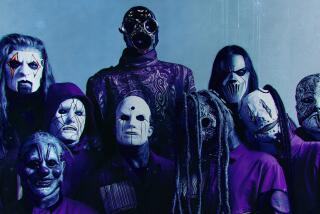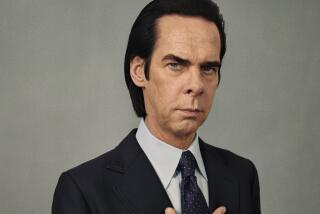Metallica and the Poetry of the Power Chord : The New Metal Is Soul Music for Suburban White Boys
There is a street-level counterculture in this country, and Tracy Chapman and Michelle Shocked don’t have much to do with it. Call it thrash, call it speed metal, call it noise, the New Metal is what the Ramones were supposed to be: physical, massively popular music more concerned with moral values than with girls and party-all-night.
The music speaks to a generation in a way punk was never able to do, populist rock ‘n’ roll that erases the line between performers and audience as it enriches them both. It appeals to the noblest sentiment of troubled adolescence just as Freddie Krueger appeals to the worst. The stuff is soul music for white boys, the over-amped cry from the heart each of them knows he could make if he only had a really good guitar, the music that brings suburban teen-agers together and holds each of them aloof from that huge segment of society that would rather stick their heads in cement mixers than listen to the latest from Slayer. Call it Jeffersonian democracy, only louder.
Neither time nor the anti-rock crusaders of the PMRC have blunted metal’s ability to enrage parents and bewilder the uninitiated. Though metal records have always sold well, the genre’s misogyny and exaggerated self-indulgence have until recently exempted it from serious consideration by the sort of people who consider pop music seriously. Plus, no rock critics listened to the stuff--their little brothers did.
But the New Metal, which started in this country more or less with the 1983 release of Metallica’s first album, “Kill ‘Em All,” stripped the bloated corpse of rock ‘n’ roll to its snarling skull. Metallica replaced leering love songs with brooding lyrics about freedom and nuclear winter--which you might have noticed if you had been able to hear the words for the splendid racket--and a horror-show appreciation of macabre death.
Elaborate stage posturing vanished. Guitar solos were, if not eliminated, pared to a minimum, while tempos increased precipitously. (It stopped being called speed metal only when somebody noticed that the best bands played slow sometimes too.) Where metal is notorious for drug excess, New Metal is usually fueled by nothing stronger than beer, if a lot of that, and over the years New Metal has become nearly as rich and varied as rock ‘n’ roll itself.
New Metal is scarcely played on the radio, and not at all on MTV. If you were to compare its most popular groups with the British Invasion bands of the ‘60s, L.A.’s Slayer (the evilest, noisiest and the best stage performers) would be analogous to the ‘65-era Stones, the ones your vice principal warned you about.
New York’s Anthrax (the cleverest, the most fun, and in a way the closest to plain-vanilla workingman’s rock) is the Who of the genre. Megadeth, another L.A. band, is the most stripped-down and cerebral: Let’s call them the Kinks. And of course Metallica is more or less akin to the Beatles, the band that for better or worse sets the industry standard.
Metallica invented American speed metal, which they promptly disowned. They were the first New Metal band to be signed to a major label (Elektra), to go gold (“Ride the Lightning”) and to sell a million (“Master of Puppets”), to play arenas (with Ozzy Osbourne in 1986), to play ballads, instrumentals or acoustic guitars.
Their intricate structures and rhythms were liberating to their musician peers and their astounding rhythmic approach to the heavy-metal riff--based on the drum rudiment rather than on the sloppy blues lick--might be the most important metal innovation since Jimi Hendrix discovered feedback.
And they blew both Van Halen and the Scorpions off the stage at this summer’s over-hyped “Monsters of Rock” shows. Sold more T-shirts too.
Before relocating to San Francisco, drummer Lars Ulrich and singer/guitarist James Hetfield formed Metallica in Norwalk--a band riffing on obscure tunes from “New Wave of British Heavy Metal” groups. The original songs they began to write were in the spirit of that speedy, no-frills tradition.
“Kill ‘Em All,” on the then-tiny Megaforce label, was the first and most influential thrash record, unpretentious and precise shards of loud-fast metal that sounded like the hard-core punk of Black Flag and the Circle Jerks but derived instead from the British headbangers like Motorhead and Diamondhead who had rid metal of its sludgy impurities in the late ‘70s.
Metallica’s poetry is the poetry of the power chord, and the clear, clean sound Hetfield and lead guitarist Kirk Hammett coaxed from their Marshall stacks was often startlingly beautiful. Suddenly, New Metal was born, and garages around the world resounded with versions of such charming Metallica numbers as “Whiplash” and “Seek and Destroy.”
The next LP, “Ride the Lightning,” explored the adolescent obsession with death: by nukes, suffocation, suicide, God’s will and the electric chair. With its stops and starts and tempo changes and introduced classical-guitar textures, it was the first mature Metallica work. The song “Fade to Black” was the sort of lonely meditation on suicide that denim-jacketed teen-age girls listen to 17 consecutive times and then burst into tears.
The lyrics ring true, which isn’t to say they’re not pretty dumb. When Metallica sings about a guy trapped under ice, they’re not alluding to the existential hopelessness of the human condition, they’re really singing about a guy trapped under ice. It’s kind of refreshing.
“I think if people could see the way some of these things were being put together,” Ulrich says, “they’d be a little disappointed. People think we have big political messages, that everything is so huge and meaningful. We’re only a rock band trying to avoid some cliches. Big freaking deal.”
“Master of Puppets,” the 1986 record that some consider the best metal album of all time, is like “Ride the Lightning” only more so: crisper, tighter, rhythmically a little like neoclassical-period Stravinsky (though Ulrich can’t quite place the name), and within the limits of the genre almost profound on the subject of manipulation and control. My little brother just says it rocks.
Last year’s “Garage Days Re-Revisited” is a goofy return to Metallica’s thrash days, an EP of rough Diamondhead and Misfits material recorded after bassist Cliff Burton, who died when the band’s tour bus skidded off an icy road in Sweden, was replaced by Jason Newsted.
And the newly released Top 10 LP “. . . And Justice for All,” a return nearly to the standard set by “Puppets,” is a slightly stodgier album, loosely structured around the theme of justice and boasting lyrics inspired in part by books by such noted metalheads as Dalton Trumbo and Nation editor Victor Navasky.
“Hey, we’re not specifically more into death than the guy down the street,” Ulrich says. “Over the last several months, we’ve talked a lot about truth and honesty and stuff like that instead.”
More to Read
The biggest entertainment stories
Get our big stories about Hollywood, film, television, music, arts, culture and more right in your inbox as soon as they publish.
You may occasionally receive promotional content from the Los Angeles Times.











